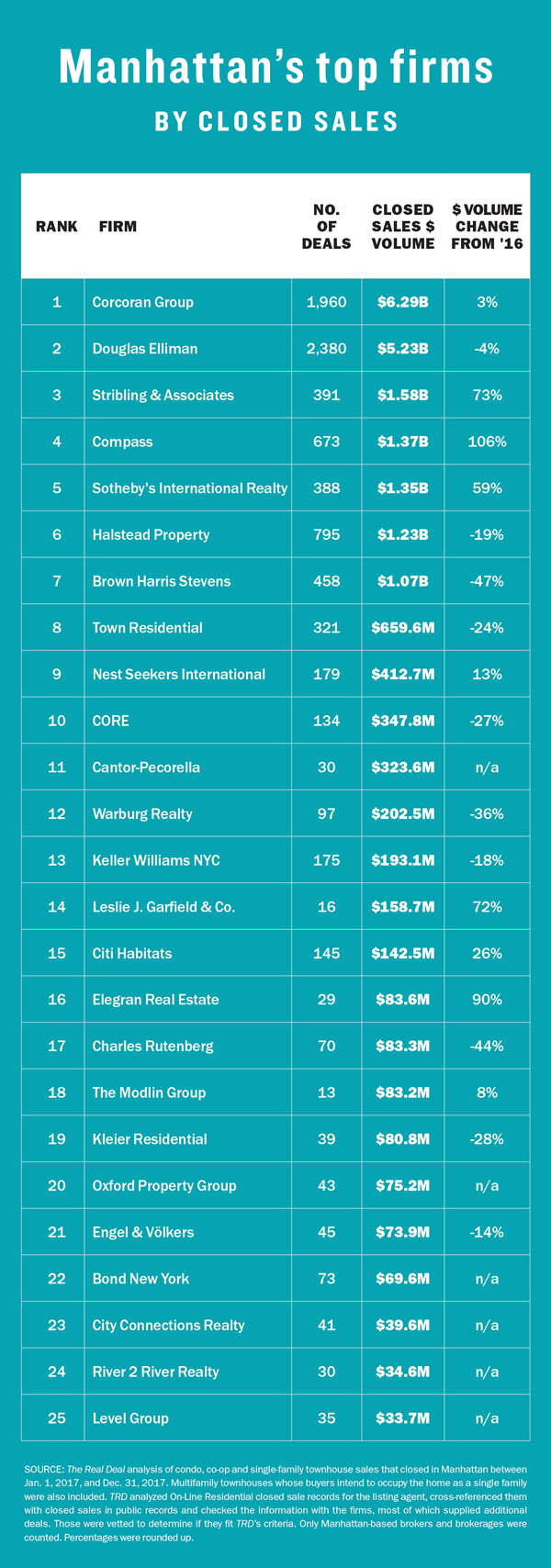UPDATED, Feb. 21, 10:54 a.m.: The Corcoran Group again led the pack in residential deals in 2017, closing $6.29 billion in Manhattan deals for 2017, according to an analysis by The Real Deal. That haul — up 3 percent from $6.13 billion in May 2016 — was driven by the firm’s new development marketing wing, Corcoran Sunshine, which sold millions of dollars of properties in buildings like 56 Leonard and the Greenwich Lane.
As usual, the firm was followed by its larger rival Douglas Elliman, which logged $5.23 billion in closed sales — down 4 percent from $5.42 billion in 2016.
Rounding out the top five were Stribling & Associates with $1.58 billion, Compass with $1.37 billion and Sotheby’s International Realty with $1.35 billion.

To determine who closed the most deals in 2017, we pulled thousands of Manhattan listings from On-Line Residential and then cross-referenced them with closed sales in public records — a firm needed to have either publicly listed the property or acted as its new development sales agent to get credit for a deal.
Collectively, the Top 25 firms closed $21.2 billion worth of listings in 2017, according to TRD’s analysis. That was up slightly from 2016’s $20.8 billion and 27 percent more than 2015’s $16.5 billion.
But the numbers don’t tell the full story. The stats in 2017 saw an artificial boost because many of the deals struck during 2015’s condo boom finally closed. In reality, it was a tough year for Manhattan’s residential brokerages as they grappled with a glut of expensive new developments and luxury resales lingered on the market.
“Anyone who tells you it was great is lying,” said Shaun Osher, the CEO of boutique brokerage CORE, adding that last year’s absorption was the slowest in two years.
“It was one of the more miserable years to be a real estate agent,” said Osher, whose firm ranked No. 10 with $347.8 million in closed sales.
Overall, however, both the number of sales and the dollar volume actually rose by 4 percent each — to 11,927 transactions valued at $24.5 billion, Miller Samuel data show.
But the majority of firms still did fewer deals in 2017 than in 2016, according to TRD’s analysis. Only nine of the Top 25 firms posted higher sales volumes.
Corcoran was one of the nine. Despite closing fewer sell-side deals in 2017 than 2016 — 1,960 versus 2,250 — the firm benefited from higher average new development prices.
Elliman, meanwhile, closed 2,380 deals — down 24 percent from 2016’s ranking, TRD’s data show. And, its total dollar volume dropped only 4 percent.
Elliman’s James said Manhattan’s one- and two-bedroom market is “tight as a tip” with demand outpacing inventory. The market up to $3 million, he added, was “pretty damn strong.”

Pam Liebman, Andrew Heiberger and Howard Lorber
Among the top 10 firms, Compass saw the strongest improvement — by a lot. The firm’s $1.37 billion in sales was up a monstrous 106 percent from $663.3 million in 2016. Stribling and Sotheby’s followed with dollar volume up 73 percent and 59 percent, respectively.
On the full ranking, No. 16-ranked Elegran Real Estate showed a sizable gain at 90 percent, closing $83.6 million deals, up from $44 million.
Stribling President Elizabeth Ann Stribling-Kivlan had two words to describe her firm’s strategy for closing sales in 2017: value play. “What Lehman taught people is to care about their pennies,” she said. “Just because you can afford it doesn’t mean you’re going to overpay for it.”
But some firms saw their numbers decline — whether because of a slower market or because they did more buy-side business.
Town, for example, finished the year with $659.6 million in closed listings, down 24 percent from $872.9 million. (TRD’s data show Town sold 321 exclusives, down from 413 in 2016.)
Town’s Andrew Heiberger, however, said that while down, his internal numbers — which include buy-side deals — showed a lower drop of 15 percent. He said Town sold just under $2 billion worth of real estate in 2017 versus $2.35 billion in 2016.
“I’m not going to apologize for doing $2 billion in sales,” said the CEO, noting that 2017 market saw “the biggest market correction since 2008.”
He said Town has sold $13 billion worth of real estate over the last seven years: “In the macro sense, we’ve had tremendous success.”
Top firms with a heavy focus on luxury were indisputably stung by lower prices and fewer deals.
According to TRD’s analysis, Brown Harris Stevens’ sell-side volume dropped 47 percent to $1.07 billion and CORE finished 27 percent down.
(BHS, however, was one of the few firms that did not provide TRD with any additional information during our vetting process and therefore likely saw its numbers undercounted.) The firm said its internal numbers — which reflected both buy- and sell-side deals — showed dollar volume dropping, but by a far lower 11.1 percent. Its total number of sales dropped by 0.8 percent, it told TRD. That dollar volume dip speaks directly to the softening prices.
“You don’t see cowboys anymore” making crazy offers, Freedman said. “It’s not a moment for aspirational pricing.”
She noted that BHS and its competitors continued to transact — albeit at lower price points.
“Price sensitivity was a constant, which is a good thing,” Willkie said. “Buyers are willing to sign contracts and close on properties when the price is justified by comparable sales.”
Editor’s note: Check out the full version of this story in the February issue
Update: After publication, Brown Harris Stevens told The Real Deal it closed $1.7 billion in 738 Manhattan sell-side deals in 2017.
